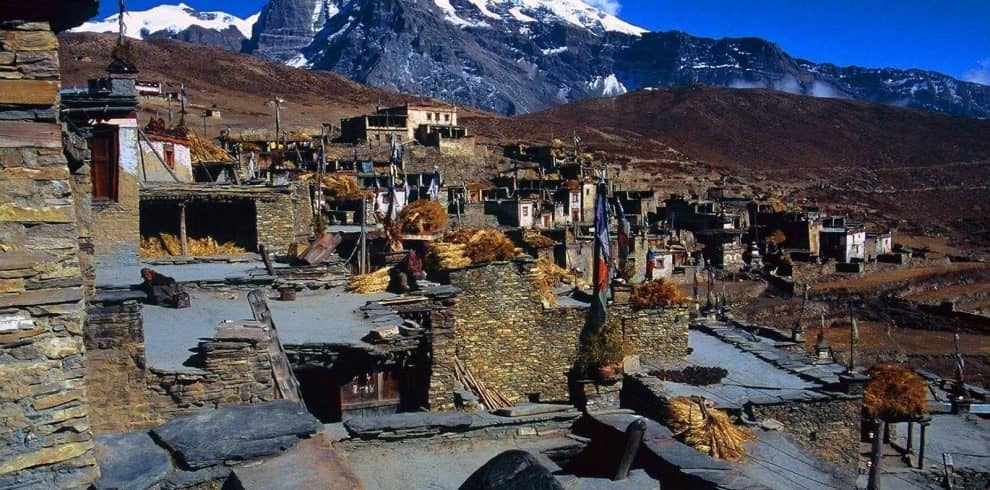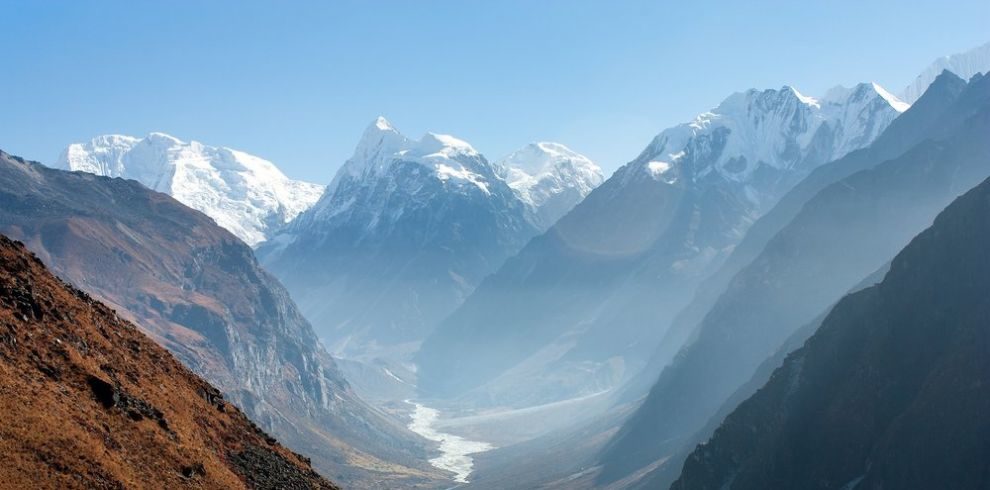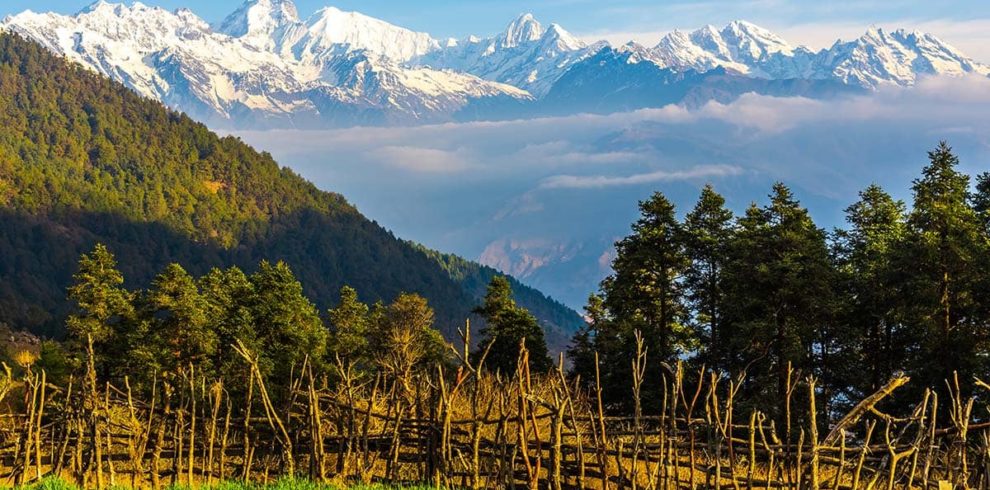Introduction To Nar Phu Valley Trekking In Nepal
The Nar Phu trekking brings you to the Annapurna region’s remote villages of Nar and Phu near Chame. It is one of Nepal’s most beautiful and unspoiled locations.
The Khampas (Tibetan refugees) live in Nar and Phu, two different but close settlements where you will get a firsthand look at their way of life.
You can see snow-capped mountains, yaks, deep gorges, tight valleys, lovely forests, stunning glaciers, and the Kang La (5,200m) and Thorong la (5,416m) high passes in addition to these communities.
At Tatopani, you’ll also take a soak in the natural hot springs. After driving to Jagat from Kathmandu, we begin our journey.
Up until Meta, we take the Annapurna circuit trail. From Meta, we cross the Marshyangdi River on a bridge that leads to Nar Phu Valley.
The short forest entryway you’ll be traveling through opens out to a massive expanse of snowy peaks, including Kang Garu, Pisang, and others.
You’ll pass through several ancient villages and monasteries on your way there. You might come across yak and blue sheep herds on occasion.
We spend a day exploring the alpine Nar valley before crossing the Kang la Pass to reach Ngwala Village. We rejoin the Annapurna Circuit at Ngwala and travel to Manang along the Annapurna Circuit.
We continue on our journey to Yak Kharka, then Thorong Phedi. Thorong Phedi is an excellent site to stay the night before traversing the treacherous Thorong La Pass, one of the world’s highest passes.
After passing via Thorong La Pass, you’ll arrive at Muktinath, a popular Hindu and Buddhist pilgrimage destination with 108 sacred sprouts and an eternal flame.
You will go from Muktinath to Jomsom and then to Tatopani. Tatopani features hot springs where you can relieve your stiff, fatigued muscles by taking a plunge.
You will return to Pokhara after spending the night in Tatopani. You’ll fly from Pokhara to Kathmandu the next morning. Your journey comes to a close in Kathmandu.
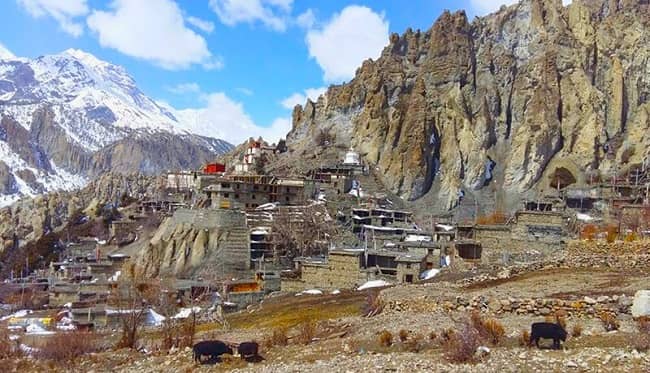
The Nar Phu Valley Trek will begin with local bus travel from Kathmandu to Besisahar, Bhulbhule, or Jagat, which would take 8-9 hours (approx. 172.9 km). The cost of the local bus travel is included in this package. However, for an additional fee, we may provide for a private jeep to make your walk more pleasant. Similarly, you can take a 20-minute flight from Pokhara to Kathmandu on your own dime. All of our valued guests are advised to be in Kathmandu before 3 p.m., at least two days prior to the trek departure date. It will give you time to attend the trek briefing, where we will offer you important journey information. Furthermore, we will inspect your luggage to ensure that you have packed all of the necessary items for the hike. It will also give us time to obtain the necessary special permit for the hike.
Highlights Of Nar Phu Valley Trekking In Nepal
- Explore Annapurna’s farthest reaches.
- Observe Tibetan culture and way of life.
- Observe yaks grazing on their pastures as you cross through the Phu, Naar, and Thorong La passes.
- Relax in Tatopani’s hot springs.
- Visit Tilicho Lake, the world’s highest lake.
- Stay at Jomsom, Mustang’s administrative capital.
- A day in Pokhara, Nepal’s tourist capital.
- Visit the Tashi Lhakhang Gompa, which is well-known.
Benefits Of Nar Phu Valley Trekking In Nepal
- Transfer from the airport to the hotel is included in a private vehicle.
- A pulse oximeter is a device that measures the amount of oxygen in the blood. It aids in the detection of altitude sickness in its early stages.
- Medical supplies
- During the walk, there is no charge for luggage storage.
- If you don’t have your own, sleeping bags and down jackets can be rented.
- In the event of an emergency, rescue arrangements are made (funded by insurance)
Equipment Checklist
Equipment list for Nar Phu trekking
You must alter the items you bring to the walk depending on the season. We recommend that you only carry the essentials. Here’s a checklist to keep in mind as you pack.
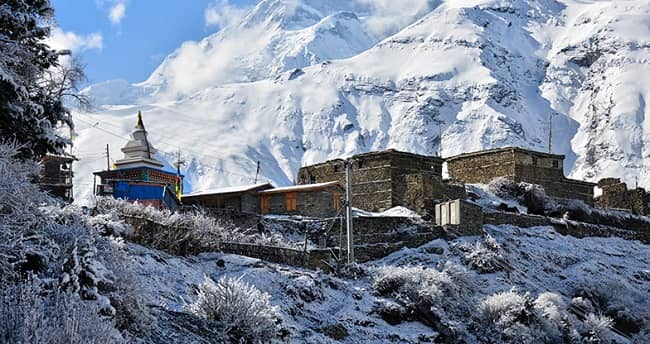
Head
- Scarf or hat for the sun
- Winter hat, insulating hat, or a hat with a wide brim
- Extra batteries for the headlight
Face
- Sunscreen
- Sunglasses that block UV rays
- Wipes for the face and body
Hands
-
Lightweight gloves
-
Heavyweight winter gloves
Body
- Shirts for hiking
- Shirt with a long sleeve made of synthetic fiber.
- Rain jacket with hood
- Jacket made of fleece
- Cotton pants that are light and airy.
- T-shirt (bring lightweight wool)
- Underwear made of polypropylene
- Jacket with down feathers (available for rent in Kathmandu)
- Sweater
- Jacket and pants that are waterproof
Footwear
- Boots for Hiking
- Socks made of thick wool (Take an extra pair of thick light socks)
Essential gear
- A daypack or a backpack (Size depends on whether you take a porter or not)
- Bottle with a heating element
- Purification of water
- Pole for hiking
- Bag for sleeping (-15 degree bag is best for high altitude trekking)
Toiletries
- a drying towel of medium size
- Toothbrush
- Toothpaste
- Deodorant/floss/toilet paper
- Biodegradable soap in a bar
- a pair of nail clippers
- Mirror, little
Personal accessories
-
Money
-
Watch
-
Cell phone
-
Camera
Extra items
- Kit for first aid
- Extra passport pictures and passport photocopies
- Pencil and notebook
- Binoculars
Trip Information
Nar Phu Valley Journey Start
At least two weekdays (Sunday – Friday) prior to the trek departure date, you must arrive in Kathmandu at Tribhuvan International Airport. The next day will be spent obtaining a restricted area trek permit to Nar Phu. Meanwhile, you’ll participate in the journey briefing.
We will present you with important trek information during the trek briefing. We’ll also go over your belongings to make sure you haven’t forgotten anything important for the hike. We will drive from Kathmandu to Jagat via Besisahar on the trek departure day.
The cost of public transportation from Kathmandu to Jagat and Jomsom to Pokhara via Tatopani is included in this trek package. A tourist bus ride from Pokhara to Kathmandu is also included. For an additional fee, we can provide private transportation.
Free airport pick up and drop off
For valued clients who have booked a package with us, we provide complimentary airport arrival and departure transfers. At the airport, our agent will be holding a leaflet with your name on it. They will greet you and give you a marigold garland or khada as a welcome gesture before driving you to your accommodation in a private vehicle.
We ask that all of our valued clients arrive in Kathmandu by 3 p.m. at least one day prior to the trip departure date. We need time to conduct a trip briefing, during which we offer you information on your journey and inspect your equipment (luggage) to ensure that you are well prepared for the walk.
Accommodation details during The Nar Phu Trek
This 16-day trek includes 14 nights of lodge-to-lodge stays in the best possible lodges/tea houses across the trek zones, as well as one night at Silver Oaks Inn in Pokhara.
You will stay in a room with an attached bathroom, TV, 24-hour hot water, power, and a laundry facility at Silver Oaks Inn in Pokhara.
Three nights in Kathmandu are required before and after the walk, however, this is not included in the package. There are hotels in Kathmandu to suit all budgets and inclinations.
In trek locations, hot showers and Wi-Fi will be offered for an additional fee.
The Meals
Because your expedition will take you to extremely high altitudes, you’ll need enough of nutrient-dense meals. We’ll provide lots of healthful food, but as you climb higher in height, your options become fewer and fewer.
During the walk, we give 16 breakfasts, 15 lunches, and 14 dinners.
The following are some of the most popular menu items:
Tsampa Porridge, Pancakes, Corn Flakes, French Toast with Jam, Oatmeal, Tibetan Bread or Chapati for breakfast Hashed Brown Eggs, Butter, Cheese, and Honey, Egg Varieties (Omelets), Muesli Breads, Fruits and Vegetables, Hot Drinks – Teas, Coffees, Hot Chocolates, and other hot beverages
Lunch – Dal, Bhat & Tarkari, Sherpa Stew, Spaghetti, Tibetan Bread, Momo (Dumplings), Macaroni Dishes, Salad, Pizza (Tomato, Mushroom, Mixed), Various Soups, Tenduk, Vegetable Curry, Potatoes, Noodles, Thukpa, Pasta, Steaks, Sandwiches, Snacks (Papad, Prawn), Desserts (Rice
Dinner – Dal (lentils), Bhat (rice), & Tarkari (curry), Tibetan Bread, Various Soups, Sherpa Stew, Sandwiches, Momo (dumplings), Macaroni Dishes, Thukpa, Pasta, Vegetable Curry, Potato Items, Papad, Prawn, Korean Ramen, Pizza (Tomato, Mushroom, Mixed), Vegetables, Salads, Tenduk, Spaghetti, N
Dinner in Pokhara is not included in the package.
We choose the best lodges that serve food that is fresh, clean, flavorful, and nutritional. In most regions, traditional, Asian, and western cuisine are available, but as we go to higher altitudes, the options become fewer.
At high elevations, we prescribe fresh vegetables and plenty of liquids such as green tea, lemon tea, hot lemon, ginger tea, and garlic soup (must).
Because the meat may not be hygienic, we do not recommend any non-vegetarian items in hiking areas. We strongly advise you to stay away from dairy products, alcoholic and caffeinated beverages, and hot chocolates.
All personal expenses (alcoholic, hot (tea/coffee), and cold drinks) in tea houses, lodges, or cafés are not included in the trek package, save for standard meals (breakfast, lunch, and dinner with seasonal fruits).
Best seasons for Nar Phu Treks
When planning a hike to Nar Phu Valley, the weather is the most important element to consider. During the spring and autumn seasons, we organize Nar Phu hikes.
March to May (Spring)
Spring Nar Phu treks are extremely popular, drawing large crowds to the Nar Phu valley. Temperatures are pleasant, skies are clear, rainfall is light, and trekking conditions are ideal during this season. In the high elevations of Nar Phu Valley, the average daily temperature ranges from 8 to 0°C. The lower parts of the hike are warmer, making it more enjoyable to walk.
After March, the trekking season begins. Even at elevations of nearly 3,000 meters, the Himalayan trek route will be decked with red, pink, and white rhododendron blossoms by April. From mid-March until mid-May, the temperature begins to rise.
September to November (Autumn)
Autumn, like spring, is a season when visitors from all over the world go to Nar Phu. Autumn is a great trekking season because of the moderate temperatures, light winds, and low precipitation.
The sun is shining brightly, the sky is clear, and you have a spectacular view of the mountains. Because the sky is clear at night, you may enjoy amazing starry skies. By early September, the monsoon will have passed, leaving mild to warm days.
In high altitudes, daytime temperatures can exceed 20°C. Temperatures drop to roughly 5°C at night. The monsoon greens fade to a golden/amber color, creating a stunning contrast against the pristine blue skies. The enclaves are where the grains are maturing. The lowlands are lush and the environment is clean. Dashain and Tihar, Nepal’s two most important holidays, fall during these months, bringing a joyous atmosphere to the country.
The weather in the Himalayas is changeable and unpredictable.
Acclimatization
For optimum acclimatization, our Nar Phu trek package includes one day of respite in Nar Village. Although altitude sickness is preventable, it can be lethal if the symptoms are ignored. We’ve planned our route to allow the body to adjust to the new altitude slowly and steadily.
All of our knowledgeable trekking leaders and guides have had thorough first-aid training. We strongly advise you to notify your group leader/guide as soon as you notice any signs of altitude sickness. Furthermore, at high altitudes, our crew will use oximeters to measure your oxygen level.
We ensure that your health is in good hands. Your trek leader or guide will also give you advice on how to avoid altitude sickness. Drinking plenty of water, taking your time, and walking at your own pace is the best way to go.
If altitude sickness is severe, the only treatment is to descend promptly. Please be aware that, depending on your overall condition, your group leader has the authority to decide whether to continue the walk or descend immediately. Please keep in mind that some people are more prone to altitude sickness than others.
Physical condition & experience requirements
The Annapurna Nar Phu Trip is a difficult trek in the Annapurna region. The hike takes around 4 to 7 hours per day, with frequent breaks to take in the breathtaking mountain vistas. Long climbs, severe descents, and straight, rocky roads are all part of the trek route.
Previous hiking experience would be beneficial, but no technical knowledge or abilities are required. The Nar Phu Valley walk can be completed by hikers who can hike for 5 to 6 hours per day at a reasonable pace with a light day pack. Some days necessitate more waking hours than others. As a result, you should be reasonably fit and ready for extended days.
Higher altitude trekking is more physically taxing than lower altitude trekking. It’s a good idea to exercise and jog daily for a couple of weeks before the trip to improve your stamina. Please keep in mind that the fitter you are, the more enjoyable the walk will be.
You must have a positive mindset, self-confidence, and a strong determination in addition to being physically healthy. Participants with pre-existing medical concerns like heart, lung, or blood illnesses should let us know before signing up for the walk.
Trekking group /single
A minimum of two trekkers is required for the Manaslu Circuit Trek. The group will be led by our qualified trek leader. We assign an assistant guide to groups of 12 or more. The larger your group, the greater the discount you will receive. You will not receive discounts if we form a group.
The Manaslu Climb takes place in a restricted area, and special permits are only provided to groups of at least two trekkers due to the nature of the trek. We welcome lone trekkers to our group, but we are unable to organize Manaslu Circuit treks for them.
A typical day on the trek
Every day takes you to new destinations as you travel through beautiful landscapes and lush vegetation. You’ll be snapping pictures, touring local communities, trying new foods, and seeing high-altitude species and lifestyles while taking in the breathtaking Himalayan backdrop.
Our guide/Sherpa will accompany you on the journey, showing you around and providing you with information about the areas you will be seeing. Porters will be assigned to carry your bags.
The day begins with a nice cup of tea or coffee in the morning, followed by a hearty breakfast, before setting out on the trails between 7 and 8 a.m., depending on the length and nature of the journey. You will have lunch after three to four hours of trekking, followed by an hour of recuperation. Then we’ll continue on our way; the afternoon walk will be shorter in general. We nibble on extra dietary food after we arrive at our location. You’ll have time to explore the area before it gets dark. Dinner will be served at approximately 7 p.m.
We engage in cordial chats and review the events of the day after dinner and before going to bed. The excursion leader/guide will give you an overview of the next day’s activities. You can read books, learn Nepali phrases from the crew, watch mountaineering movies, or play games like monopoly or cards after the briefing.
How to Communicate During the Trek?
For a nominal fee, you can use the internet at the lodges, but after you reach high elevations, you’ll have to communicate via phone.
Our office will connect with all of our valued clients by Signal, WhatsApp, phone, Messenger, and other means at least once a day to ensure that they are fine, safe, and comfortable.
You might get some signals along the route, depending on the network you’re using, but they’re not particularly strong at high altitudes. In Kathmandu, though, you may easily obtain a local sim card.
In most cases, you will be able to connect to the internet at all of the lodges/hotels where you will be staying.
Wi-Fi is usually available during the walk-in lodges/lodges for an additional fee.
Extra personal expenses on trekking
In Kathmandu, the clients are responsible for their own meals and lodging. You may book them conveniently online, or we can do it for you if you want.
Similarly, you must pay for visa processing, travel insurance, beverages, trip snacks, hot and cold drinks, souvenirs, and tips to trekking crew members, among other things. Bringing cash (Dollars) and changing it to Rupees is recommended. In the Nepali market, only Rupees are accepted.
Electricity, battery recharge, water on trekking
In all lodges, electricity for camera and phone recharge is available at an additional expense. During the trip, you can either buy pre-packaged mineral water or bring boiled water with you. You will also receive a water-purifying pill.
We advise against drinking water from rivers or taps because the water may be contaminated.
Trek travel insurance
This Trek requires travel insurance. Before beginning the hike, all trekkers must produce a copy of their comprehensive travel insurance policy certificate to us. Medical and emergency repatriation must be covered, as well as helicopter rescue and evacuation costs at high altitudes (up to 6000m).
Based on the experiences of our former clients, we may recommend insurance firms to you. We do not, however, sell insurance coverage. Within a week of booking the trek, we ask that all trek participants provide us with their comprehensive insurance information. In an emergency, we’ll prepare a speedy, successful rescue using your insurance policy and other documentation you supplied us.
Before you acquire travel insurance, call your provider and double-check that it covers helicopter rescue and evacuation up to 6000 meters. Do not rely solely on the material of the insurance company’s website.
How to get a visa for Nepal?
Except for Indian nationals, all foreigners must have a valid visa to enter Nepal. At Tribhuvan International Airport and Nepal’s borders with India and Tibet, you can obtain an on-arrival visa. Visit www.immigration.gov.np. for additional details.
You’ll need a passport that’s valid for at least six months, a passport-size photo, and visa fees to apply for a visa. A 30-day visa costs $50 at the moment (to be paid in cash).
A free visa will be given to children under the age of ten. It is strongly recommended that you examine the current regulations. Visa regulations are subject to change at any time. Citizens of China and members of the South Asian Association for Regional Cooperation (SAARC) (Bangladesh, Bhutan, India, Maldives, Pakistan, and Sri Lanka) are exempt from visa fees.
Certain countries’ citizens may be denied a visa upon arrival. On-arrival visas are not available for citizens of Nigeria, Ghana, Zimbabwe, Swaziland, Cameroon, Somalia, Liberia, Ethiopia, Iraq, Palestine, and Afghanistan. If you are a citizen of one of these countries, please contact the Nepalese Embassy in your country.
Before we embark on our journey, we’ll double-check everything (luggage, equipment, etc.) during our briefing.
Currency Exchange in Nepal | USD to NPR
Nepali Rupees (NPR/Rs) are the local currency.
(1 USD = ~ Rs.124 NPR).
You can exchange major foreign currencies through local banks and legitimate money exchanges in Kathmandu and all over Thamel. Legitimate money exchanges display their ongoing exchange rates visibly to the public.
Please note – only 100 INR (Indian Rupees) and 2000 INR notes are legal in Nepal.
Despite having the security advantage of traveler’s cheques, we prefer cash exchange. It helps avoid lengthy processes and high bank commissions.
You can withdraw cash (in Rupees)from ATMs all over Kathmandu and Thamel itself. Many of these ATMs are open around the clock. The maximum withdrawal amount is 35,000 Rupees for a 500 Rupees processing fee for foreign cards.
If you use the money exchange facilities at banks and financial institutions, they impose a service charge fee of about 4% or more.
During the trek, there are no banks and money exchange services so you should exchange your money in Kathmandu, depending on how much personal expense you require. Only Nepali Rupee is accepted in trekking regions.
Most established banks in Asia will only accept foreign currency notes that are not old, torn, or faded. Please ensure that you have new, clean notes.
How much luggage can I take during the Trek?
Your luggage must not exceed 9 kilograms per trekker. One porter will be allocated to each of the two trekkers, and the total weight of their luggage should not exceed 18 kg. Our porters are never overworked.
You may, however, need to bring your own knapsack or backpack (with valuables or anything important). Carry only what you need. Excess baggage can be safely stored at your hotel or at our store for no charge.
Before we begin the journey, we will double-check everything (luggage, equipment, etc.) during our briefing.
Trek Safely
All of our clients’ safety, security, and happiness are guaranteed by us. We place the highest priority on your safety. For each trip, we will bring all of the essential gear, equipment, and first-aid kits. Our guides and leaders have completed thorough first-aid training.
If a trekker becomes ill as a result of the altitude, we will analyze the situation and keep everyone safe. In the event of an emergency, the rescue chopper will be on standby to transport you back to the lower elevation. Every team member will be together for safety during the walk, and there will be no danger of being lost in hazardous terrains.
Responsible travel
Our philosophy is to photograph the voyage while leaving only footsteps. We believe in sustainable tourism and exclusively offer eco-friendly excursions.
We collaborate with the Kathmandu Environmental Education Project (KEEP) to plan eco-friendly itineraries that satisfy the needs of both tourists and local populations in the trekking areas.
Our Crew
Our knowledgeable guide/Sherpa will accompany us on the trek to ensure your safety and comfort. Your stuff will be carried by porters.
Our members are locals from high Himalayan remote places, and they have exceptional physical endurance at high altitudes.
We value all of our employees, so we pay them well and take care of their insurance, clothing, food, and lodging throughout the trip. When our guides and porters become unwell or injured, they receive medical attention.
Only happy people can make others happy, thus we always make sure that our team members are happy. Members of our trek/expedition team have the following qualifications:
- Authorized Trekking Guide Training Certificate
- Intensive Wilderness First Aid Training
- Fluency in English and another major language
- Conservation and Biodiversity Training
- Experience with rock climbing
Tipping during trek
Tipping is optional and should be dependent on the quality of service received. A tip is an accepted and respected technique in Nepali society to express gratitude (Dhanyabad) for good service.
On the last day of the walk, the majority of our guests offer advice. The amount you tip is totally up to you, and it may be more or less based on your impression of service quality, the length of your trip, your budget, and your appreciation for their efforts.
100% Guaranteed Booking
We are a government-approved and bonded trek and tour company in Nepal. We are also members of the Nepal Mountaineering Association (NMA) and the Trekking Agency Association of Nepal (TAAN) (NMA). As a result, you may book your trek/expedition with complete trust.
As a deposit, we require 10% of the total trip cost. Within a week of booking, please send your documentation, including a copy of your passport, passport-size pictures, travel insurance policy, and arrival and departure flight information.
You can make a 10% deposit via bank transfer, western union, or online payment on our website, and the full balance when you arrive in Nepal. Cash, bank transfer, and credit cards are all acceptable methods of payment. In addition, you will receive payment choices in your email.
Last-minute Trek booking in Nepal
Even though it is always a good idea to plan ahead for your excursions. However, for those who are unable to do so, we provide a special last-minute booking option. To take advantage of this benefit, you must pay the entire trip cost 24 hours before the trek’s departure.
Even while we do our best to plan treks at any time, there is a small potential of a trek delay due to events beyond our control, such as the inability to obtain air tickets or unfavorable weather.
Can I extend my trip?
If you wish to stay in Nepal for a few days after the trip, we can arrange enjoyable activities for you, such as exploring areas in and around Kathmandu, Chitwan jungle safari, paragliding, rafting, canoeing, and so on.
Feedback
We offer a farewell meal at the end of the trek, and we will also award you with a trek completion certificate after dinner (hard copy). It’s also a great opportunity to tell us about your experience and provide us feedback.
You may also visit Nepal Tour-Cost, Distance, Itinerary, In Nepal – 10 Days
Overview Of Nar Phu Valley Trekking
- The Nar Phu valley Trek brings you to distant Nar and Phu villages near Tibet across multiple high passes, lovely villages, deep woods, historic monasteries, and tight canyons.
- As the walk progresses, you’ll pass by spectacular chortens and herds of blue sheep in some of the world’s most pristine terrain. You’ll return to the Annapurna Circuit trails after visiting the Nar Phu Valley.
- This unique combination of off-the-beaten-path and well-known activities ensures an exciting trekking experience.
